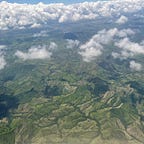The Atlantis of CO2 Emissions
The solution we are looking for
We are producing carbon dioxide at such a fast rate that we are struggling to cope.
Climate.gov states, “Each year, human activities release more carbon dioxide into the atmosphere than natural processes can remove, causing the amount of carbon dioxide in the atmosphere to increase. The global average carbon dioxide set a new record high in 2021: 414.72 parts per million”.
We engraved the use of CO2 in our society, and trying to pull the plug on those emissions is becoming harder and harder. To balance out the needs of our community, we need to find a way to displace the CO2 being produced so not all of it is in the air. Part of the problem is we are struggling to take advantage of all the resources our planet provides.
A way to distribute CO2, so it’s less harmful, can be through the ocean. Researchers have found a process called ocean alkalinity enhancement which can achieve the exact solution we need to be successful in our emission goals. It may be our solution to minimizing how much of our emissions go into the atmosphere.
Here’s how this process works
Ocean alkalinity enhancement is a faster process mimicking the longer geological carbon process where rocks are weathered by rain and atmospheric CO2, which then washes into the ocean as alkaline molecules. It speeds up the process by combining CO2-rich gas with rocks and seawater, creating the proper chemical balance we need in the rocks.
This enhancement traps the CO2 in these rocks and acts as a CO2 vault. Another reason this process is trustworthy is that the side effects can benefit the atmosphere and the ocean. Adding these alkaline rocks into the sea can reduce ocean acidity, helping restore many harmed food webs.
According to Ocean Alkalinity, “To give a sense of scale, if you were to remove all the CO2 from the atmosphere and put it in the oceans, it would only increase the amount of carbon in ocean chemistry by 2%”.
This is just another advantage to storing CO2 in the ocean and proves we can use the ocean’s vastness without harming it. However, this process is relatively new and requires more research to ensure how the sea and wildlife react.
Once we know all the possible outcomes, this solution could save us from our dark fate.
To fully implement this solution, we will need the help of our policymakers and make them aware of the situation. Without their help, regulating and implementing this solution will be very difficult since the oceans are a sensitive topic over who has control; therefore, implementing this solution without their help may cause disputes.
Many parts of this process need to be researched, but being aware of all the possible solutions can help us create new ones to help us leap toward our emissions goal.
